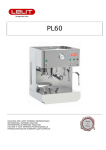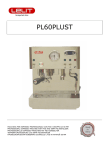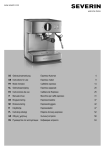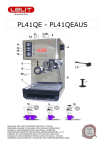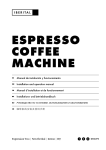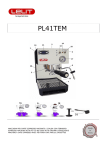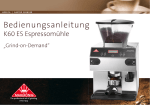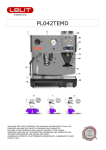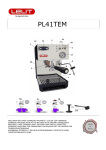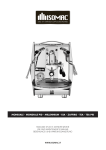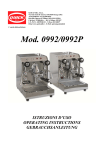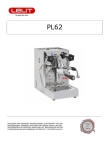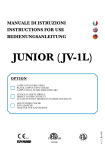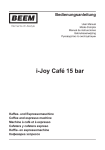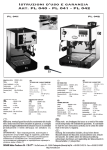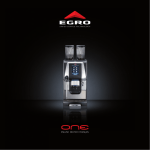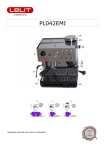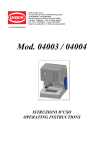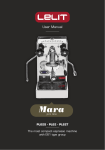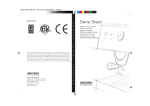Download MC557_PL60T libretto in allestimento - it-ing-de-fr-ru - ok
Transcript
PL60T MACCHINA PER CAFFE’ ESPRESSO PROFESSIONALE CON TERMOPID PROFESSIONAL ESPRESSO MACHINE WITH PID PROFESSIONALLE ESPRESSO-MASCHINE MIT PID-GEREGELTER TEMPERATURSTEUERUNG MACHINE A’ CAFE ESPRESSO PROFESSIONNELLE AVEC PID ПРФЕСИОНАЛЬНАЯ КОФЕВАРКА ЭСПРЕССО С PID ДЛЯ ИСПОЛЬЗОВАНИЯ МОЛОТОГО КОФЕ/ ТАБЛЕТИРОВАННОГО КОФЕ 2 Italiano COMPONENTI: 1. 2. 3. 4. 5. 6. 7. 8. 9. 10. 11. 12. 13. 14. Cavo di alimentazione Interruttore generale on/off Spia pronto vapore Spia pronto caffè Interruttore caffè Interruttore generale vapore Manometro Coperchio vaschetta raccogli acqua Interruttore vapore Lancia vapore Beccuccio erogazione acqua calda Portafiltro 2 vie Ghiera attacco portafiltro Rialzo rimovibile per tazzine espresso 15. 16. 17. 18. 19. 20. 21. 22. 23. 24. 25. 26. 27. 28. Griglia poggiatazze PID regolatore di temperatura Spia mancanza acqua Coperchio scaldatazze Coperchio contenitore acqua Interruttore acqua calda Spia accensione interruttore acqua calda Pressino caffè Misurino caffè \ Filtro 1 tazza Filtro 2 tazze Filtro cialda Filtro resine ISTRUZIONI PER L’USO: Prima accensione della macchina: 1. 2. 3. 4. 5. 6. 7. 8. 9. Estrarre la macchina dalla scatola e rimuovere tutti i sacchetti e tutto il materiale da imballo. Posizionare la macchina per caffè espresso su una superficie stabile e piana, lontano da fonti di calore e da rubinetti della rete idrica. Alzare (oppure rimuovere completamente) il piccolo coperchio rimovibile (19) posto sulla parte superiore della macchina; estrarre con attenzione il tubicino in plastica con il filtro anti-calcare già inserito; in seguito, estrarre il serbatoio di plastica. Riempire il serbatoio con acqua fredda. Rimettere il serbatoio nella sua sede, inserire il tubicino in plastica con il filtro anti-calcare all’interno e chiudere con il piccolo coperchio (19). Inserire la spina del cavo di alimentazione (1) nella presa di corrente (verificare che l'alimentazione elettrica sia idonea alle necessità del prodotto stesso). Inserire il portafiltro (12) nella ghiera di aggancio del portafiltro (13), ruotandolo con forza da sinistra verso destra, in modo che il portafiltro si scaldi e che sia poi pronto per l’utilizzo. Accendere la macchina premendo l'interruttore generale (2); il LED integrato nell'interruttore conferma l'accensione: si aziona automaticamente l'accensione del gruppo caffè e la ricarica della caldaia vapore. Contemporaneamente alzare/accendere l'interruttore acqua calda (20): non appena esce acqua dal beccuccio erogazione acqua calda (11) abbassare/speganere l'interruttore acqua calda (20). Premere l'interruttore (6) che aziona il riscaldamento caldaia vapore: la spia pronto caffè (4) e la spia pronto vapore (3) si accendono per confermare che la macchina è pronta per l'uso. 10. Il regolatore di temperatura Termopid (16) visualizzerà i gradi della caldaia caffè, controllando il riscaldamento. 11. Il regolatore di temperatura e’ impostato dalla fabbrica a 95°C , temperatura ideale per la preparazione del caffè. (Se si desidera cambiare la temperatura del Termopid, seguire le istruzioni del paragrafo Regolazione della temperatura in caldaia tramite il controllo Termopid). Preparazione del caffè espresso con caffè macinato: 12. Controllare che il serbatoio interno contenga acqua. ATTENZIONE: il serbatoio interno è munito di un dispositivo galleggiante che controlla la presenza ed il livello dell'acqua. Dovesse mancare l'acqua nel serbatoio, la spia mancanza acqua (17) si accende in automatico e contemporaneamente parte il segnale acustico del buzzer. Solo rimettendo acqua fredda nel serbatoio interno (come descritto nel paragrafo Prima accensione della macchina, ai punti 3-5) la spia si spegnerà ed il buzzer smetterà di suonare, confermando il livello idoneo dell'acqua. NB: Il serbatoio deve essere riempito fino al livello MAX indicato sulla carrozzeria. 13. Seguire le istruzioni del punto 9 in caso le operazioni ivi descritte non fossero ancora state compiute. 14. Non appena il display del Termopid (16) visualizza la temperatura impostata e la lampada spia segnalatrice pronto caffè (4) si accende, la macchina è pronta per l’uso. 15. Inserire il filtro (25-26) nel portafiltro (12). Versare la quantità di caffè macinato desiderata (1 misurino (23) corrisponde a 1 dose di caffè, per 2 tazzine versare 2 misurini) nel portafiltro (12), pressare il caffè con il pressino (22) ed alla fine inserire il portafiltro (12) nell’anello di aggancio della sede del portafiltro (13) ruotandolo da sinistra verso destra con forza. 16. Posizionare la/le tazzina/e sulla grata removibile poggia tazza (14). NB: La macchina è prevista per utilizzo di tazzine espresso da posizionare sul piano rimovibile (14) e per utilizzo di tazze mug con un altezza massima di 11cm da posizionare direttamente sulla griglia (15). 17. NB: L’interruttore caffè (5) ha 2 posizioni: in alto acceso, in basso spento. Accendere l’interruttore caffè (5) ed una volta raggiunta la quantità di caffè desiderata abbassare l'interruttore a leva (5) per arrestare l’erogazione. 18. Togliere il portafiltro (12) dalla ghiera (13) e gettare via i fondi di caffè. NB: Per mantenere il gruppo caffè alla temperatura giusta si raccomanda di lasciare il portafiltro (12) vuoto (senza caffè) agganciato nel suo supporto (13). 3 Italiano Vapore: Controllare che il serbatoio interno contenga acqua. ATTENZIONE: il serbatoio interno è munito di un dispositivo galleggiante che controlla la presenza ed il livello dell'acqua. Dovesse mancare l'acqua nel serbatoio, la spia mancanza acqua (17) si accende in automatico e contemporaneamente parte il segnale acustico del buzzer. Solo rimettendo acqua fredda nel serbatoio interno (come descritto nel paragrafo Prima accensione della macchina, ai punti 3-5) la spia si spegnerà ed il buzzer smetterà di suonare, confermando il livello idoneo dell'acqua. NB: Il serbatoio deve essere riempito fino al livello MAX indicato sulla carrozzeria. Attivare il gruppo vapore premendo l’interruttore generale (6) (se non è stato precedentemente premuto): in seguito, a conferma, si accenderà la spia tensione (3): la macchina ha raggiunto la giusta temperatura ed è pronta per l’erogazione del vapore. Mettere sotto il tubo vapore multi-direzionale (10) il recipiente con la bevanda desiderata. Alzare l’interruttore di erogazione vapore (9) lasciando la lancia vapore sempre immersa nel liquido per evitare eventuali spruzzi di bevanda calda. Abbassare l’interruttore vapore (9) per arrestare l’erogazione ed estrarre la lancia (10) dal liquido ad erogazione terminata. Il tubo erogazione vapore (10) può diventare molto caldo per cui si consiglia di maneggiarlo esclusivamente tramite l’apposita protezione in gomma. Pulire accuratamente l’erogatore vapore (10) con un panno umido. 19. 20. 21. 22. 23. 24. 25. Acqua calda: Controllare che il serbatoio interno contenga acqua. ATTENZIONE: il serbatoio interno è munito di un dispositivo galleggiante che controlla la presenza ed il livello dell'acqua. Dovesse mancare l'acqua nel serbatoio, la spia mancanza acqua (17) si accende in automatico e contemporaneamente parte il segnale acustico del buzzer. Solo rimettendo acqua fredda nel serbatoio interno (come descritto nel paragrafo Prima accensione della macchina, ai punti 3-5) la spia si spegnerà ed il buzzer smetterà di suonare, confermando il livello idoneo dell'acqua. NB: Il serbatoio deve essere riempito fino al livello MAX indicato sulla carrozzeria. Attendere che il display del Termopid (16) visualizzi la temperatura impostata e che la spia pronto caffè (4) si accenda. Porre un recipiente sotto il beccuccio acqua calda (11) ed alzare l’interruttore acqua calda (20). La spia (21) conferma accensione. Ad ottenimento della quantità desiderata abbassare l’interruttore acqua calda (20) per arrestare l’erogazione. Dopo il prelievo di acqua calda si raccomanda di controllare che il serbatoio interno contenga acqua ed eventualmente di ripristinare il livello come indicato al punto 24. 26. 27. 28. 29. REGOLAZIONE DELLA TEMPERATURA IN CALDAIA TRAMITE IL CONTROLLO TERMOPID: Il Termopid e’ stato impostato dalla fabbrica a 95°c. Per poter intervenire sulla regolazione procedere come segue: 1. premere il tasto ; non appena sul display compare la scritta “PRG” premere il tasto ; 2. quando il display visualizza la temperatura della caldaia , impostare con i tasti e il valore della temperatura desiderata, da un minimo di 80C° ad un massimo di 130C°. 3. dopo 3 secondi dalla pressione dell’ultimo tasto il dato è memorizzato ed il display visualizza la temperatura. NB: se la temperatura viene impostata ad una soglia troppo elevata, sotto la richiesta di erogazione caffè il display comincerà a lampeggiare. MANUTENZIONE ORDINARIA E PRECAUZIONI: Si consiglia di pulire il tubo vapore (10) dopo ogni utilizzo. Per la pulizia della macchina utilizzare un panno umido d’acqua. Non lasciare l’apparecchio esposto ad agenti atmosferici. Non immergere l’apparecchio in acqua. Fare funzionare l’apparecchio soltanto sotto controllo di adulti e tenerlo fuori dalla portata dei bambini. Non lavare filtri e portafiltro in lavastoviglie. Durante il normale funzionamento alcune parti della carrozzeria della macchina possono raggiungere temperature elevate: maneggiare con cautela! - Il dispositivo controllo temperatura Termopid e’ stato impostato a valori di fabbrica per un caffè espresso ottimale. Durante il riscaldamento e l’erogazione di caffè o acqua la temperatura può avere un’oscillazione di 10/12°C in + o in – rispetto a quella impostata. E’ stato inserito anche un avvertimento: dopo i 108°C il display del Termopid visualizza la temperatura ma ad intermittenza; e’ del tutto normale, in quanto questo avverte l’operatore che il caffè non uscirà buono se erogato con una temperatura cosi alta. Nota Bene: La macchina è dotata di un serbatoio d’acqua con una capacità di 2,7l predisposto con rilevatore di mancanza acqua collegato ad una spia allarme (17) ed un buzzer. Il suono del buzzer per segnalare la mancanza dell'acqua al momento dell'accensione della macchina è diverso dal suono emesso per segnalare la mancanza durante il normale funzionamento. Il ripristino del livello dell'acqua nel serbatoio determinerà sia lo spegnimento della spia allarme (17) sia l'interruzione del buzzer. Se l'acqua finisce durante il normale funzionamento il rilevatore mancanza acqua consente 15sec. di tempo per fare il caffè; un volta finita l'erogazione del caffè si consiglia di riempire il serbatoio fino al livello max. indicato. Si prega di leggere attentamente le istruzioni d’uso e di controllare periodicamente il livello dell’acqua nel serbatoio interno. 4 Italiano Filtro a resine in dotazione (montato sul tubo pescaggio acqua, all'interno del serbatoio): serve a proteggere il meccanismo interno dai depositi di calcare; è un addolcitore usa e getta specifico per macchine da caffè che va cambiato in base a durezza e consumo dell’acqua seguendo le indicazioni nella tabella sotto: Durezza acqua Quantità 10°F 90 litri 20°F 45 litri 27°F 35 litri 35°F 23 litri 45°F 20 litri NB: E’ necessario cambiare il filtro dopo il consumo della quantità acqua indicata nella tabella sopra, altrimenti i depositi di calcare possono danneggiare la macchina (danno non coperto dalla garanzia). DATI TECNICI: Alimentazione elettrica: 220-230V: 50Hz - 220-230V: 60Hz Resistenza caffè: 1000W Resistenza vapore: 1200W Pressione pompa caffè: 12/15 bar Pompa caldaia caffè ULKA: 48W -- Pompa caldaia vapore ULKA: 21W Regolazione Termopid: da min. 80°C fino a max. 130°C Capacità serbatoio acqua: 2,7 litri Capacità caldaia caffè: 250 ml -- Capacità caldaia vapore: 400 ml Dimensioni (HxLxP): 30x30x42 cm -- Peso netto: 10,5 kg Funzionamento: caffè macinato / cialde carta PL60T/110 120V – 60 Hz – 20 Amp RISOLUZIONE DEI PROBLEMI PIÙ FREQUENTI: Gentile Cliente, La ringraziamo per aver acquistato un nostro prodotto, costruito secondo le ultime innovazioni tecnologiche. Seguendo scrupolosamente le semplici operazioni riguardanti l’uso corretto del nostro prodotto in conformità alle prescrizioni essenziali di sicurezza indicate nel presente manuale, potrà ottenere il massimo delle prestazioni e verificare la notevole affidabilità di questo prodotto nel corso degli anni. Di seguito forniamo una pratica tabella riportante alcuni malfunzionamenti e le loro relative rapide soluzioni: PROBLEMI Il caffè esce troppo freddo Il caffè esce troppo rapidamente Il caffè esce tra il gruppo erogazione ed il portafiltro Il caffè esce a gocce La macchina non eroga vapore con interruttori (6) e (9) accesi La macchina non funziona e la spia dell’interruttore non si accende CAUSA SOLUZIONE 1. Rispettare le indicazioni riportate nei paragrafi “messa in funzione della macchina” e “preparazione del caffè espresso” 1. La macchina non è a giusta temperatura. 2. Il portafiltro deve essere riscaldato 2. Mancato preriscaldamento del portafiltro contemporaneamente all’acqua, vedi 3. Mancato preriscaldamento delle tazze paragrafo “messa in funzione della macchina” 4. Il termostato non lavora entro i valori ottimali. 3. Scaldare adeguatamente le tazze sull’apposito scadatazze (18) 4. Rivolgersi al CENTRO DI ASSISTENZA 1. La quantità di caffè è insufficiente 1. Aumentare la dose di caffè 2. Pressatura del caffè insufficiente 2. Premere maggiormente il caffè 3. Caffè vecchio o inadatto 3. Sostituire il caffè 1. Inserirlo in modo corretto 1. Il portafiltro non è inserito correttamente 2. Diminuire la quantità di caffè 2. Eccessiva quantità di caffè nel filtro 3. Togliere I residui di caffè dal bordo del 3. Il bordo del portafiltro non è stato pulito portafiltro pulire la guarnizione sottocoppa. 4. La guarnizione sottocoppa è usurata 4. Rivolgersi al CENTRO DI ASSI STENZA 1. La quantità di caffè è eccessiva 1. Diminuire la quantità di caffè 2. Eccessiva pressatura del caffè 2. Pressare meno il caffè 1. Micropompa non funzionante 1. Rivolgersi al CENTRO DI ASSI STENZA 2. Il foro del terminale del tubo vapore è ostruito 2. Pulire il foro con l’ausilio di un ago 3. Manca acqua nel serbatoio 3. Vedi paragrafo “messa in funzione della macchina” 1. Controllare inserimento spina e presa 1. Possibile disconessione dalla rete elettrica. corrente. 2. La spina del cavo di alimentazione non è inserita 2. Inserire correttamente la spina del cavo di correttamente alimentazione nella presa di corrente 3. Il cavo di alimentazione è danneggiato 3. Rivolgersi al CENTRO DI ASSISTENZA per la sostituzione del cavo 5 AVVERTENZE PER IL CORRETTO SMALTIMENTO DEL PRODOTTO AI SENSI DELLA DIRETTIVA EUROPEA 2002/96/EC Alla fine della sua vita utile il prodotto non deve essere smaltito insieme ai rifiuti urbani. Può essere consegnato presso gli appositi centri di raccolta differenziata predisposti dalle amministrazioni comunali, oppure presso i rivenditori che forniscono questo servizio. Smaltire separatamente un elettrodomestico consente di evitare possibile conseguenze negative per l’ambiente e per la salute derivanti da un suo smaltimento inadeguato e permette di recuperare i materiali di cui è composto al fine di ottenere un importante risparmio di energia e di risorse. Per rimarcare l’obbligo di smaltire separatamente gli elettrodomestici, sul prodotto è riportato il marchio del contenitore di spazzature mobile barrato. DICHIARAZIONE DI CONFORMITA’ CE Gemme Italian Producers srl dichiara sotto la propria responsabilità che il prodotto PL60T, al quale è riferita questa dichiarazione, è conforme alle seguenti norme: CEI EN 60335-1, CEI EN 60335-2-15 Dichiara inoltre che il prodotto sopra indicato risulta conforme in base alle prove di compatibilità elettromagnetica EMC. NB: La presente dichiarazione perde la sua validità se la macchina viene modificata senza la nostra espressa autorizzazione. Castegnato, 01/07/2011 Amministratore Delegato L’elenco aggiornato dei centri assistenza autorizzati LELIT è disponibile all’indirizzo http://www.lelit.com/web/assistenza.asp . I dati e le immagini riportati potranno subire variazioni senza preavviso al fine del miglioramento delle prestazioni della macchina. 6 English COMPONENTS : 1. 2. 3. 4. 5. 6. 7. 8. 9. 10. 11. 12. 13. 14. Power cord Main switch on/off Steam ready pilot light Coffee ready pilot light Coffee switch Steam group main switch Manometer Cover for water tray Steam switch Steam tube with safety protection Hot water tube Filter holder (2 ways) Support for filter holder connection Removable tray/grill for espresso cup 15. 16. 17. 18. 19. 20. 21. 22. 23. 24. 25. 26. 27. 28. Drip grill / grill for mug PID coffee boiler temperature controller Water missing pilot light Cup warming on top of the machine Removable cover for water tank Hot water switch Hot water pilot light Tamper Coffee doser \ Filter 1 cup Filter 2 cups Filter for pods Resin filter (inside water tank) USER INSTRUCTIONS: Starting the machine: 1. 2. 3. 4. 5. 6. 7. 8. 9. Remove the machine from its packing and make sure all packing parts have been taken off (including the protection bags). Lay the machine on a flat and steady surface far away from hot places and from the water taps. Remove the water tank cover (19) on the top of the machine; extract the plastic tube that has a resin filter (28) attached; extract the water tank. Fill the tank with cold water. Replace the water tank back in the machine; insert the plastic tube and pay attention not to bend it; replace the cover (19) in its right position. Insert the power cord (1) in the mains. Make sure that the wall socket is of the right voltage. Place the filter holder (12) under the brewing group (13) and turn it from the left to the right. Leave it there so that it can get warm and it gets ready for use. Turn on the machine by pressing the main switch (2); the build-in pilot light confirms that the machine is on. The coffee group and the steam boiler recharge go on automatically. Press the hot water toggle switch (20) up: once water will flow out of the water tube (11) press the toggle switch (20) down. Press the steam group main switch (6) in order to turn on the boilers’ heating element: the coffee ready pilot light (4) and the steam ready pilot light (3) will come on confirming that the machine is ready for use. 10. The PID (16) will visualize the degrees inside the boiler and will control the boiler’s heating. 11. The PID is already set from the producer on 95°C, i.e. the ideal temperature for a good cup of coffee. (If you want to change the PID’s temperature, please follow the instructions written under How to set the temperature inside the boiler by means of the PID). Making an espresso with ground coffee: 12. 13. 14. 15. 16. 17. 18. Check that the tank contains water. ATTENTION: the internal tank has a special floating device that controls the water level. In case of lack of water, the water missing pilot light (17) comes on automatically and at the same time the sound alarm buzzes. Please fill the water tank with water (as described under Starting the machine, points 3-5): this will shut off the pilot light (17) and the buzzer, confirming that the water level is suitable. NB: the water tank must be filled in with water till the MAX level indicated on the appliance body. Follow the instruction at point 9 in case the above written operations have not been yet done. As soon as the PID’s (16) display shows the set temperature and the coffee ready pilot light (4) goes on, the machine is ready for use. Place the filter (25-26) in the filter holder (12). Lock the filter holder (12) in the brewing group (13) turning it from the left to the right, after having poured the desired quantity of ground coffee (1 doser (23) corresponds to 1 coffee dose; to get 2 coffee cups pour 2 dozers of ground coffee in the filter holder (12) ) and after having pressed it properly with the pressing tool/tamper (22). Place the espresso cup/s on the cup rest (14). NB: this machine has a removable tray (14) for espresso cups and a drip grill (15) for cups/mug of max. 11cm height. NB: The coffee switch (5) has 2 positions: up it’s on, down it’s off. Turn the coffee switch on (5) to start brewing and once you have reached the desired quantity of coffee press the toggle switch (5) down to stop dispensing the coffee. Remove the filter holder (12) from its support (13) and throw away the coffee grounds. NB: Place the filter holder (12) empty (without coffee) back in its support (13) in order to maintain the entire coffee group at the suitable temperature. Steam: 19. 20. 21. Check that the tank contains water. ATTENTION: the internal tank has a special floating device that controls the water level. In case of lack of water, the water missing pilot light (17) comes on automatically and at the same time the sound allarm buzzes. Please fill the water tank with water (as described under Starting the machine, points 3-5): this will shut off the pilot light (17) and the buzzer, confirming that the water level is suitable. NB: the water tank must be filled in with water till the MAX level indicated on the appliance body. Switch on the steam group by pressing the steam main switch (6) (only if it has not been yet done): the pilot light (3) gets on. The machine is at the right temperature, ready to make steam. Place the cup/mug with the drink to be heated under the steam tube (10). 7 English 22. 23. 24. 25. Press the toggle steam switch (9) up paying attention that the steamer always stays immerse in the liquid, to avoid possible hot drink sprays. Press the toggle steam switch (9) down to stop steaming and remove the steam tube (10) from the cup/mug. The steam tube (10) can become extremely hot so make sure to handle it only touching the rubber safety protection. Clean the steam tube (10) accordingly with a normal damp cloth. Hot water: 26. 27. 28. 29. Check that the tank contains water. ATTENTION: the internal tank has a special floating device that controls the water level. In case of lack of water, the water missing pilot light (17) comes on automatically and at the same time the sound allarm buzzes. Please fill the water tank with water (as described under Starting the machine, points 3-5): this will shut off the pilot light (17) and the buzzer, confirming that the water level is suitable. NB: the water tank must be filled in with water till the MAX level indicated on the appliance body. Wait till the PID’s (16) display shows the set temperature and the coffee ready pilot light (4) comes on. Place a mug under the hot water faucet (11) and press the hot water switch (20) up: the pilot light (21) confirms the starting. Once you get the desired amount of hot water press the switch (20) down to stop dispensing. After having taken hot water, always check that there is still water in the tank and if it is necessary, fill the water tank as indicated at point 24. HOW TO SET THE BOILER’S TEMPERATURE BY MEANS OF THE PID: The PID has been set by the producer of this machine on a temperature of 95°C. In order to change the temperature please proceed as follows: 4. press the button ; as soon as the display shows the writing “PRG” press the button ; 5. as soon as the display shows the boiler’s temperature, help yourself with the buttons and in order to set the desired temperature, starting from a min. of 80C° up to a max. of 130C°. 6. after 3 sec. from pressing the last button, the inserted temperature is memorized and the display shows the set temperature. NB: if the temperature is set too high, once a coffee request is made, the display starts to flash. ROUTINE MAINTENANCE AND PRECAUTIONS: − Clean up the steam tube (10) after every use. − Use a normal damp cloth to clean the machine. − Do not leave the machine outdoors. − Do not immerse the machine in water. − Use the machine only under adult control and keep it away from children’s reach. − Do not wash filters and filter holder in the dishwasher. − During normal functioning some parts of the appliance body can reach high temperatures: please handle with due caution! − The PID is already set by the producer on the right temperature for an excellent espresso. During heating and coffee or water distribution, the temperature can oscillate (+/- 10/12°C). Also, a warning has been inserted: after 108°C the PID’s display shows the temperature but intermittently; this is normal and it warns the user that the coffee will not be good if made with such high temperature. ATTENTION: the machine is equipped with a water tank of 2.7l with missing water sensor connected to an allarm pilot light (17) and also to a buzzer. The sound of the buzzer caused by the lack of water at starting the machine is different from the sound made to indicate the lack of water during normal funtioning. The restoration of the suitable water level will shut off the allarm pilot light (17) and the buzzer. If the water finishes during the normal funtioning the missing water sensor will allow 15sec. of time to finish the coffee; once the coffee is done the water tank must be filled with water till the max level indicated on the appliance body. We suggest reading the instruction booklet carefully and checking the water level in the water tank regularly. Water softener included (inserted on the plastic tube, inside the water tank): one way water softener for espresso machines. It protects the machine from limestone residues. It needs to be replaced according to the water hardness and consumption following the below table: Water hardness Quantity 10°F 90 lt 20°F 45 lt 27°F 35 lt 35°F 23 lt 45°F 20 lt NB: It’s is necessary to replace the resin filter as indicated above otherwise the limestone residues can damage the coffee machine (the warranty does not cover this type of damage). 8 English Technical data: Power supply: 220-230V: 50Hz - 220-230V: 60Hz Coffee heating element: 1000W Steam heating element: 1200W Coffee pump pressure: 12/15 bar Pump on coffee boiler (ULKA): 48W -- Pump on steam boiler (ULKA): 21W PID’s regulation: from 80°C up to 130°C Water tank capacity: 2,7 litri Coffee boiler capacity: 250 ml – Steam boiler capacity: 400 ml Dimensions (HxLxP): 30x30x42 cm – Net Weight: 10,5 kg To be operated with ground coffee or coffee pods PL60T/110 120V – 60 Hz – 20 Amp TROUBLESHOOTING: We thank you for buying one of our products, projected and assembled in accordance with the most up-to date technological innovations. Following carefully the simple operations described in this manual, which respect to all essential safety regulations, you will get the best performances and will appreciate the remarkable reliability of this product in the years to come. Please find below the description of the most frequent problems and of their solution: PROBLEM Coffee too cold CAUSE 1. The machine had not reached the proper temperature 2. Filter-holder not preheated 3. Cups not preheated 4. Thermostat malfunctions. Coffee comes out too quickly Coffee leaks between the coffee group and the filter-holder Coffee comes out in drops The machine does not produce steam even if the LED (6) and (9) are on The machine does not work and the ON light does not turn on. 1. Too little coffee in the filter 2. Coffee not pressed enough 3. Coffee is old or unsuitable 1. Filter-holder not properly inserted 2. Too much coffee in the filter 3. Edge of the filter-holder not clean 4. The douche seal is worn out or damaged 1. Too much coffee in the filter 2. Coffee too firmly pressed 1. Micro pump not functioning 2. Obstructed outlet hole at end of steam pipe 3. Too little water in tank 1. No electricity/power supply 2. The power cable is not properly plugged in. 3. The power cable is damaged SOLUTION 1. See section “Starting the Machine” and “Making an Espresso” 2. Filter-holder must be heated together with the water – see section “Starting the Machine” 3. Properly heat the cups on the cup-warmer (18) 4. Contact the nearest SERVICE CENTER 1. Put more coffee in the filter 2. Press coffee more firmly 3. Use a different coffee blend 1. Insert the filter-holder correctly 2. Put less coffee in the filter 3. Clean the edge of the filter-holder 4. Contact the nearest SERVICE CENTER 1. Put less coffee in the filter 2. Press the coffee more gently 1. See section “Steam” 2. Clean the outlet hole with a needle 3. See section “Starting the Machine” 1. Check and restore the electrical power 2. Plug in the power cable correctly 3. Contact the nearest SERVICE CENTER for a replacement cable IMPORTANT INFORMATION FOR CORRECT DISPOSAL OF THE PRODUCT IN ACCORDANCE WITH EC DIRECTIVE 2002/96/EC At the end of its working life, the product must not be disposed of as urban waste. It must be taken to a special local authority differential waste collection centre or to a dealer providing this service. Disposing of a household appliance separately avoids possible negative consequences for the environment and health deriving from inappropriate disposal of enables the constituent materials to be recovered to obtain significant savings in energy and resources. As a reminder of the need to dispose of household appliances separately, the products is marked with a crossed-out wheeled dustbin. EC DECLARATION OF CONFORMITY Gemme Italian Producers srl declares under its own responsibility that the product PL60T, to which this declaration relates, is in accordance with the provisions of the specific directives: CEI EN 60335-1, CEI EN 60335-2-15 It also declares that the above mentioned product conforms with the electromagnetic compatibility test EMC. NB: The present declaration voids should the machine be modified without our specific authorization. Castegnato, 01/07/2011 Amministratore Delegato The inserted data and pictures can be subject to changes without previous notice for the improvement of the machine’s performances. 9 Deutsch Komponenten: 1. Stromkabel 2. Hauptschalter An/Aus 3. Leuchtdiode Dampf 4. Leuchtdiode Espresso 5. Kipphebelschalter Espresso 6. Hauptschalter An/Aus Dampf 7. Manometer 8. Abdeckung Wasserauffangschale 9. Kipphebelschalter Dampf 10. Dampfhahn 11. Auslaßhahn für Heißwasser 12. Siebträger mit Zwei-Nasen-Auslauf 13. Siebträgeraufnahme 14. Entfernbare Erhöhung für Espresso-Tassen 15. 16. 17. 18. 19. 20. 21. 22. 23. 24. 25. 26. 27. 28. Tassenabstellfläche / Abstellgrill Thermo-PID-Steuerung Leuchtdiode “fehlendes Wasser” Passiv beheizte Tassenabstellfläche auf der Maschine Abdeckung für Wassertank Kipphebelschalter für Heißwasser-Entnahme Leuchtdiode bei Heißwasser-Entnahme Press-Stempel / Tamper Meßlöffel caffè \ Filter 1 Tasse Filter 2 Tassen Filter für cialde/pads Harzfilter für Wasseransaugschlauch Bedienungsanleitung: Erstinbetriebnahme: 1. 2. 3. 4. 5. 6. 7. 8. 9. Entnehmen Sie die Maschine der Verpackungsschachtel und entfernen Sie alle weiteren Verpackungsmaterialien wie Plastik etc. Stellen Sie die Maschine auf eine ebene und stabile Fläche und halten Sie die Maschine fern von Wärmequellen und/oder Wasserquellen. Öffnen Sie den Deckel für das Wasserbehälterfach (19), welches sich hinten oben auf der Maschine befindet und entnehmen Sie vorsichtig die Wasserschläuche, an dessen Ende sich bereits der Harzfilter (28) befindet. Danach entnehmen Sie den Wasserbehälter. Befüllen Sie den Wassertank mit frischem kaltem Wasser. Stellen Sie den Wasserbehälter anschließend wieder an seinen vorgesehenen Platz zurück und führen die Schläuche mit dem Harzfilter wieder in den Wassertank ein und kontrollieren Sie, dass die beiden Schläuche nicht geknickt sind. Anschließend den Deckel (19) wieder schließen. Schließen Sie das Stromkabel der Maschine (1) an eine Steckdose an und beachten Sie die korrekte Stromspannung. Nehmen Sie den Siebträger (12) und setzen diesen in die Siebträgerhalterung (13) ein, indem Sie den Siebträger von links nach rechts hineindrehen. Damit kann der Siebträger sich aufwärmen und ist somit leichter bereit für die spätere Nutzung. !! Schalten Sie die Maschine an, indem Sie den Hauptschalter (2) betätigen. Das Aufleuchten des Lämpchen des gleichen Hauptschalters zeigt Ihnen die Stromversorgung der Maschine an. Die Maschine beginnt nun automatisch den Kessel für Espresso/Heißwasser und den Kessel für Dampf zu füllen bzw. aufzuheizen. Stellen Sie nun sofort den Kipphebel für Heißwasser (20) an und warten solange, bis heißes Wasser aus dem Auslaßhahn (11) kommt. Dann stellen Sie den Kipphebelschalter für Heißwasser (20) wieder ab. Nun sind die Kessel korrekt befüllt. Dieser wichtige Vorgang muss nur bei Erst-Inbetriebnahme erfolgen, danach nicht mehr. !! Betätigen Sie den Hauptschalter für Dampf (6), dadurch heizt der Dampfkessel auf. Nach einer kurzen Aufheizphase signalisiert das Aufleuchten der Leuchtdiode für espressso (4) und der Leuchtdiode für Dampf (3), dass die EspressoMaschine bereit zur Nutzung ist. Anmerkung. Beide Kreisläufe können auch einzeln geschaltet werden, möchten Sie lediglich espresso beziehen, ohne Milch aufzuschäumen, kann der Bereich Dampf mit dem Hauptschalter (6) ausgeschaltet bleiben. 10. Die Thermo-PID-Steuerung (16) zeigt die Heizkesseltemperatur an und kontrolliert die Temperatur im Heizkessel. 11. Die Thermo-PID-Steuerung ist ab Werk auf 95 Grad eingestellt, die ideale Temperatur für die EspressoZubereitung. (Wenn Sie die Temperatur der Thermo-PID-Steuerung ändern möchten, befolgen Sie bitte die Anleitungen im Kapitel „Regelung der Heizkesseltemperatur mit Hilfe der Thermo-PID-Steuerung“) Zubereitung eines caffè mit gemahlenem Pulver: 12. 13. 14. 15. 16. 10 Stellen Sie sicher, dass der Wasserbehälter (1) mit Wasser befüllt ist. ACHTUNG: Der Wassertank ist mit einem Schalter ausgestattet, welcher die Menge des Wassers überwacht. Sollte nicht genügend Wasser im Wassertank sein oder gar kein Wasser sich im Wassertank befinden, leuchtet die Diode “fehlendes Wasser” (17) automatisch auf und gleichzeitig ertönt ein Warnton. Erst wenn Sie wieder frisches Wasser in den Wasserbehälter füllen (wie in den Punkten 3-5 des Absatzes Erstinetriebnahme beschrieben) geht die Leuchtdiode aus und der Warnton ertönt nicht mehr und es wird somit die korrekte Befüllung des Wassertankes bestätigt. Beachten: Der Wasserbehälter soll bis zum MaximumStand befüllt werden, dieser Maximum-Stand ist am Gehäuse angezeigt. Befolgen Sie bitte die Anweisungen des Punktes 9, sollte dieser noch nicht ausgeführt worden sein. Sobald die Thermo-PID-Steuerung (16) die eingestellte Temperatur anzeigt und die Leuchtdiode espresso (4) aufleuchtet, ist die Maschine betriebsbereit. Setzen Sie den Filter (25 – 26) in den Siebträger (12). Füllen Sie die gewünschte Menge an Espresso-Pulver in den Siebträger (1 Meßlöffel (23) entspricht der Menge für einen espresso mit dem kleinen Sieb, 2 Meßlöffel entsprechen der Menge für zwei espressi mit dem großen Sieb), drücken Sie das Pulver mit dem Preßstempel/Tamper (22) an und setzen den Siebträger dann in die Siebträgeraufnahme (13) ein, indem Sie den Siebträger kräftig von links nach rechts eindrehen. Anschließend positionieren Sie die Espresso-Tassen auf der Tassenabstellfläche (14) unter den Auslauf des Siebträgers. Beachten: Die Maschine kann sowohl mit kleinen Espresso-Tassen benutzt werden, welche auf die entfernbare Erhöhung für Espresso-Tassen (14) abgestellt werden können, als auch für größere Tassen mit einer max. Höhe von 11 cm, welche direkt auf die Tassenabstellfläche (15) abgestellt werden. Deutsch 17. 18. Achtung: Der Kipphebelschalter für espresso (5) hat 2 Positionen: nach oben “an”, nach unten “aus”. Nachdem Sie den Kipphebelschalter für espresso (5) angestellt haben und die gewünschte Menge an espresso erhalten haben, stellen Sie den Kipphebel für espresso (5) auf aus, um den Espresso-Bezug zu beenden. Entnehmen Sie nun den Siebträger (12) aus der Siebträgeraufnahme (13) und werfen den nassen “Puck” (restliche Pulver) weg. Achtung: Um den Siebträger/Siebträgeraufnahme in der richtigen Temperatur zu halten, empfiehlt es sich, den Siebträger (12) leer in der Siebträgeraufnahme (13) zu belassen. Dampfentnahme: 19. 20. 21. 22. 23. 24. 25. Stellen Sie sicher, dass der Wasserbehälter (1) mit Wasser befüllt ist. ACHTUNG: Der Wassertank ist mit einem Schalter ausgestattet, welcher die Menge des Wassers überwacht. Sollte nicht genügend Wasser im Wassertank sein oder gar kein Wasser sich im Wassertank befinden, leuchtet die Diode “fehlendes Wasser” (17) automatisch auf und gleichzeitig ertönt ein Warnton. Erst wenn Sie wieder frisches Wasser in den Wasserbehälter füllen (wie in den Punkten 3-5 des Absatzes Erstinbetriebnahme beschrieben) geht die Leuchtdiode aus und der Warnton ertönt nicht mehr und es wird somit die korrekte Befüllung des Wassertankes bestätigt. Beachten: Der Wasserbehälter soll bis zum MaximumStand befüllt werden, dieser Maximum-Stand ist am Gehäuse angezeigt. Stellen Sie den Dampfbereich an, indem Sie den Hauptschalter Dampf (6) drücken (wenn dies nicht schon vorher erfolgt ist). Dann leuchtet zur Bestätigung die Leuchtdiode Dampf (3) auf; die Maschine hat die richtige Temperatur erreicht und ist für den Dampfbezug betriebsbereit. Halten Sie nun unter die multi-direktionale (in alle Richtungen bewegliche) Dampflanze ein geeignetes Gefäß (idealerweise ein Edelstahl-Milchkännchen) mit dem gewünschten Getränk (Milch). Stellen Sie nun den Kipphebelschalter für Dampf (9) an und lassen die Spitze der Dampflanze immer eingetaucht in der Flüssigkeit, um eventuelle Spritzer der heißen Flüssigkeit zu vermeiden. Anmerkung: Wenn Sie Milch aufschäumen wollen, halten Sie die Spitze der Dampfdüse nur knapp unter der Milchoberfläche und halten Sie die Dampflanze dann dort ruhig ohne große Bewegungen. Dann entwickelt sich am besten ein korrekter Milchschaum. Weiterer Tipp: Nehmen Sie zum Milchaufschäumen immer kühle Milch und füllen das Gefäß (Milchkännchen) mindestens bis zur Hälfte. Stellen Sie den Kipphebelschalter für Dampf (9) aus, um den Dampfbezug zu beenden und ziehen Sie die Dampflanze (10), wenn kein Dampf mehr aus dieser austritt, aus der Flüssigkeit. Die Dampflanze wird sehr heiß, es wird daher empfohlen, diese ausschließlich an dem - an der Dampflanze befindlichen - Gummischutz anzufassen. Reinigen Sie die Dampflanze (10) anschließend gründlich mit einem nassen Tuch. Anmerkung: Die Spitze der Dampflanze kann abgeschraubt werden, um diese zu reingen. Heißwasser-Entnahme: 26. 27. 28. 29. Stellen Sie sicher, dass der Wasserbehälter (1) mit Wasser befüllt ist. ACHTUNG: Der Wassertank ist mit einem Schalter ausgestattet, welcher die Menge des Wassers überwacht. Sollte nicht genügend Wasser im Wassertank sein oder gar kein Wasser sich im Wassertank befinden, leuchtet die Diode “fehlendes Wasser” (17) automatisch auf und gleichzeitig ertönt ein Warnton. Erst wenn Sie wieder frisches Wasser in den Wasserbehälter füllen (wie in den Punkten 3-5 des Absatzes Erstinetriebnahme beschrieben) geht die Leuchtdiode aus und der Warnton ertönt nicht mehr und es wird somit die korrekte Befüllung des Wassertankes bestätigt. Beachten: Der Wasserbehälter soll bis zum MaximumStand befüllt werden, dieser Maximum-Stand ist am Gehäuse angezeigt. Warten Sie, bis die Thermo-PID-Steuerung (16) die eingestellte Temperatur anzeigt und die Leuchtdiode Espresso (4) aufleuchtet. Stellen Sie ein Gefäß unter den Auslaßhahn für Heißwasser (11) und stellen den Kipphebelschalter für HeißwasserEntnahme (20) an. Die Leuchtdiode für Heißwasser (21) leuchtet auf und bestätigt die Heißwasser-Entnahme. Wenn die gewünschte Menge an Heißwasser erreicht ist, stellen Sie den Kipphebelschalter für Heißwasser (20) ab, um den Bezug zu beenden. Nach der Heißwasser-Entnahme empfiehlt es sich, den Wasserstand im Wasserbehälter (1) zu überprüfen und gegebenenfalls diesen wieder zu befüllen wie in Punkt 24 beschrieben. Regelung der Heizkesseltemperatur mithilfe der Thermo-PID-Steuerung Die Thermo-PID-Steuerung ist ab Werk auf 95 Grad eingestellt. Um die Temperatursteuerung zu verändern, gehen Sie bitte wie folgt vor: - Drücken Sie die Taste ▼; sobald auf dem Display die Schrift „PRG“ erscheint, drücken Sie die Taste ▲. - Wenn das Display nun die eingestellte Heizkesseltemperatur anzeigt, können Sie die gewünschte Temperatur mit den Tasten ▲ und ▼einstellen, zwischen Minimum 80°C und Maximum 130°C. - 3 Sekunden nach Bedienung der letzten Taste wird der eingestellte Wert gespeichert und die Temperatur kann am Display abgelesen werden. Anmerkung: Wenn die Temperatur auf einen zu hohen Wert eingestellt wird, beginnt das Display zu blinken, sobald man einen Espresso zubereiten will. GRUNDSÄTZLICHE PFLEGEHINWEISE UND VORSICHTSMAßNAHMEN: Es empfiehlt sich, die Dampflanze (10) nach jeder Benutzung zu reinigen. Für die Reinigung der Maschine ein weiches feuchtes Tuch benutzen. Die Maschine keinen atmosphärischen Störungen aussetzen. Die Maschine niemals in Wasser tauchen. Die Maschine darf nur unter Kontrolle von Erwachsenen bedient werden und muss von Kindern ferngehalten werden. Den Siebträger und die Filter nicht in der Geschirrspülmaschine reinigen. 11 Deutsch Während des Betriebes der Maschine kann diese an verschiedenen Teilen sehr heiß werden; bitte lassen Sie große Vorsicht walten!! Die Temperaturregelung des Thermo-PID ist ab Werk auf einen optimalen Wert für einen Espresso eingestellt. Während der Aufheizzeit, des Espressobezuges oder der Warmwasserentnahme kann die Temperatur eine Schwankung aufweisen von +/- 10/12 Grad von der eingestellten Temperatur. Darüber hinaus ist im Thermo-PID eine Warnung einprogrammiert worden. Über 108 Grad hinaus zeigt der Thermo-PID die Temperatur an, jedoch blinkend! Dies ist normal, warnt jedoch den Nutzer, dass der Espresso bei einer solch hohen Temperatur nicht korrekt herauslaufen wird. Beachten: Die Maschine ist mit einem Wasserbehälter mit einem Fassungsvermögen von 2,7 Liter ausgestattet, gekoppelt mit einem Wasserstandsmelder, der bei Wassermangel mit einer Leuchtdiode (17) und einem akustischen Warnton reagiert. Der Klang des Warntons, der beim Einschalten der Maschine bei Wassermangel ertönt, unterscheidet sich vom Warnton, der im normalen Betrieb der Maschine ertönt. Das Wieder-Auffüllen des Wasserbehälters beendet sowohl das Aufleuchten der Leuchtdiode für Wassermangel (17) als auch den Warnton. Wenn das Wasser während des normalen Betriebes ausgeht, bedeutet das Aufleuchten/der Warnton noch eine Zeit von ca. 15 Sekunden zum Beendigen des caffè. Wenn der Bezug des espresso beendet ist, empfiehlt es sich, den Wassertank wieder bis maximal aufzufüllen. Es wird darum gebeten, die Bedienungsanleitung aufmerksam zu lesen und regelmäßig den Wasserstand im Wasserbehälter zu kontrollieren. Harzfilter (montiert auf dem Ansaugschlauch im Inneren des Wasserbehälters) dient dem Schutz des Inneren der Maschine vor Verkalkung; es handelt sich um einen Verschleißfilter, welcher je nach Gebrauch und Dauer gemäß der folgenden Tabelle gewechselt werden soll: Wasserhärtegrad Menge Wasserhärtegrad Menge 10°F 90 Liter 35°F 23 Liter 20°F 45 Liter 45°F 20 Liter 27°F 35 Liter Beachten: Der Wechsel des Filters ist notwendig gemäß der obigen Tabelle, ansonsten können Schäden/Probleme durch Kalk entstehen, die nicht im Rahmen der Garantie/Gewährleistung abgedeckt sind. Wir empfehlen trotz der Verwendung des Harzfilters, die Maschine je nach örtlichem Härtegrad Ihres Leitungswassers regelmäßig mit einem speziellen Entkalker für Espresso-Maschinen zu entkalken. Technische Daten: Stromaufnahme: 220-230V: 50Hz - 220-230V: 60Hz Leistung Bereich espresso: 1000W Leistung Bereich Dampf: 1200W Pumpe Bereich espresso: 12/15 bar Pumpe Leistung Bereich espresso ULKA: 48W – Pumpe Leistung Dampf ULKA: 21W PID Regulierung: von min. 80°C bis zum max. 130°C Kapazität Wasserbehälter: 2,7 Liter Kesselgröße für Epresso: 250 ml – Kesselgröße für Dampf: 400 ml Abmessungen (HxLxP): 30x30x42 cm -- Nettogewicht: 10,5 kg Betriebsmöglichkeit: gemahlenes Pulver / pads – cialde PL60T/110 120V – 60 Hz – 20 Amp 12 Deutsch HÄUFIGE PROBLEME UND HILFESTELLUNGEN: Sehr geehrter Kunde, wir bedanken uns, dass Sie ein Produkt von uns erworben haben, welches nach den neuesten technologischen Errungenschaften konstruiert wurde. Bei korrektem Einhalten sämtlicher Bedienungsanweisungen für unser Produkt und bei Einhalten aller oben beschriebenen Vorsichtsmaßnahmen, können Sie von der ganzen Produktqualität, des ganzen Produktergebnisses und der Produktzuverlässigkeit über Jahre profitieren. Im Folgenden finden Sie eine Tabelle, in der häufige Fragestellungen/Probleme und deren Lösungen und/oder Hilfestellungen beschrieben sind. PROBLEM GRUND LÖSUNG 1. Beachten Sie die Punkte der Anleitung “Inbetriebnahme der Maschine” und 1. Die Maschine hat (noch) nicht die korrekte “Zubereitung eines espresso” Betriebstemperatur. Der espresso wird zu 2. Der Siebträger sollte vorgewärmt werden, 2. Siebträger nicht vorgewärmt kalt siehe Punkt “Inbetriebnahme der Maschine” 3. Tassen nicht vorgewärmt 3. Erwärmen Sie die Tassen auf der passiv 4. Das Thermostat arbeitet nicht korrekt beheizten Abstellfläche (18). 4. Wenden Sie sich an ein Lelit Service Center 1. Die Pulvermenge reicht nicht aus. 1. Pulvermenge erhöhen Der espresso läuft zu 2. Das Pulver ist zu wenig fest angedrückt. 2. fester Antampern schnell durch 3. Das Pulver ist veraltet oder die Mahlung zu grob 3. Pulver ersetzen oder feiner mahlen 1. Siebträger korrekt einspannen Der espresso tritt 1. Siebträger nicht korrekt eingespannt 2. Weniger Pulver verwenden zwischen Siebträger 2. Zuviel Pulver im Siebträger 3. Entfernen Sie die Pulverreste vom und 3. Der Siebträger-Rand ist unsauber Siebträger und Säubern der Siebträgerhalterung 4. Die Siebträgerdichtung ist abgenutzt Siebträgerdichtung aus 4. Wenden Sie sich an ein Lelit Service Center 1. Die Pulvermenge ist zu groß 1. Weniger Pulver verwenden Der espresso tritt nur 2. Zu starkes Tampern des Pulvers 2. weniger fest antampern in Tropfen aus 3. Mahlung zu fein 3. Bohnen gröber mahlen Die Maschine 1. Dampfpumpe funktioniert nicht 1. Wenden Sie sich an ein Lelit Service Center 2. Reinigen Sie die Dampfspitze mit Hilfe produziert keinen 2. Die Dampfspitze ist ev. verstopft mit Milchresten einer Nadel Dampf mit den 3. es fehlt Wasser im Wasserbehälter Schaltern (6) und (9) 3. Siehe “Inbetriebnahme der Maschine” Die Maschine 1. Möglicherweise Problem des häuslichen 1. Kontrollieren Sie Stromkreis und Steckdose 2. Den Stecker des Stromkabels der Maschine funktioniert nicht und Stromkreises. die Leuchtdiode des 2. Das Stromkabel der Maschine ist nicht korrekt korrekt einstecken Hauptschalters eingesteckt. 3. Wenden Sie sich an ein Lelit Service Center leuchtet nicht auf. 3. Das Stromkabel der Maschine ist beschädigt zum Wechsel des Stromkabels. WICHTIGER HINWEIS FÜR DIE KORREKTE ENTSORGUNG DES PRODUKTS IN ÜBEREINSTIMMUNG MIT DER EG-RICHTLINIE 2002/96/EG Am Ende seiner Nutzzeit darf das Produkt NICHT zusammen mit dem Siedlungsabfall beseitigt werden. Es kann zu den eigens von den städtischen Behören eingerichteten Sammelstellen oder zu den Fachhändlern, die einen Rücknahmeservice anbieten, gebracht werden. Die getrennte Entsorgung eines Haushaltsgerätes vermeidet mögliche negative Auswirkungen auf die Umwelt und die menschliche Gesundheit, die durch eine nicht vorschriftsmäßige Entsorgung bedingt sind. Zudem ermöglicht wird die Wiederverwertung der Materialien, aus denen sich das Gerät zusammensetzt, was wiederum eine bedeutende Einsparung an Energie und Ressourcen mit sich bringt. Zur Erinnerung an die Verpflichtung, die Elektrohaushalsgeräte zu beseitigen, ist das Produkt mit einer Mülltonne, die durchgestrichen ist, gekennzeichnet. CE–KONFORMITÄTSERKLÄRUNG Gemme Italian Producers srl erklärt auf einige Verantwortung, dass PL60T, auf das sich diese Erklärung bezieht, der Vorschriften der spezifischen Richtlinien CEI EN 60335-1, CEI EN 60335-2-15 entspricht. Die o.g. Firma erklärt, dass die oben genannten Produkte gemäß der EMC elektromagnetischen Verträglichkeitstesten produziert sind. NB: Die vorliegende Erklärung verliert Ihre Gültigkeit, wenn die Maschine ohne unsere ausdrückliche Genehmigung verändert wird. Castegnato, 01/07/2011 Amministratore delegato Die eingefügten Daten und Fotos können ohne Voranmeldung verändert werden, um die Leistungen des Produkts zu verbessern 13 Français COMPONENTS : 1. 2. 3. 4. 5. 6. 7. 8. 9. 10. 11. 12. 13. 14. Câble alimentation Interrupteur général on/off Indicateur lumineux vapeur prête Indicateur lumineux café prêt Interrupteur café Interrupteur général vapeur Manomètre Couvercle cuve décharge eau Interrupteur vapeur Buse vapeur Distributeur eau chaude Porte filtre 2 sorties Siege du porte-filtre Support amovible pour les tasses espresso 15. Grille amovible appuie-tasses 16. PID dispositif contrôle température 17. 18. 19. 20. 21. 22. 23. 24. 25. 26. 27. 28. Indicateur lumineux manque d’eau Chauffe tasses passif Couvercle réservoir d’eau froide Interrupteur eau chaude Indicateur lumineux interrupteur eau chaude Presseur pour café / tamper Cuillère doseuse \ Filtre 1 tasse Filtre 2 tasses Filtre pour dosettes Cartouche filtrante à résines MODE D’EMPLOI: Mise en route de la machine: 1. 2. 3. 4. 5. 6. 7. 8. 9. Otez la machine de la boite et éloignez tous les sachets et le matériel d’emballage. Positionnez la machine sur une surface stable et plane, loin de fontes de chaleur et de robinets du réseau hydrique. Levez (ou enlevez complètement) le couvercle amovible (19) du réservoir mis sur la partie supérieure de la machine ; enlevez avec attention le tube en plastique sur lequel est inséré la cartouche filtrante à résines (28); ensuite, ôtez le réservoir. Remplissez le réservoir avec de l’eau froide. Remettez le réservoir dans son siège, en contrôlant que le tube avec la cartouche filtrante à résines (28) soit à l’intérieur et fermez le couvercle (19). Insérez la fiche du câble d’alimentation (1) dans la prise de courant (vérifiez que le voltage soit juste pour le produit même). Insérez le porte filtre (12) dans le siège du porte filtre (13) en rotant de gauche à droite, de sorte qu’il se réchauffe et qu’il soit prêt à l’emploi. Allumez la machine en appuyant sur l’interrupteur général (2). L’indicateur lumineux intégré s’illuminera pour confirmer l’alimentation au réseau électrique et en même temps pour confirmer l’allumage du groupe café et la recharge de la cuve vapeur. Ensuite levez/allumez l’interrupteur eau chaude (20) : dès que de l’eau chaude sort du distributeur eau chaude (11) fermez/abbaissez l’interrupteur eau chaude (20). Appuyez l’interrupteur (6) qui allume le réchauffement de la cuve vapeur : l’indicateur lumineux café prêt (4) et l’interrupteur lumineux vapeur prête (3) s’allument pour confirmer que la machine est prête à l’emploi. 10. Le PID (16) montre les degrés à l’intérieur de la chaudière, en contrôlant la réchauffement. 11. Le PID est déjà régulé par le producteur de cette machine à 95°C, c’est à dire la température optimale pour la préparation d’un bon café. (Si vous désirez changer cette température, vous êtes priés de suivre les instructions fournies dans le paragraphe Comment réguler la température dans la cuve avec l’aide du PID) Préparation du café espresso avec du café moulu: 12. 13. 14. 15. 16. 17. 18. 14 Contrôlez que le réservoir contient de l’eau froide. ATTENTION : le réservoir est muni d’un dispositif flottant qui surveille sur la présence et le niveau de l’eau. Au cas où l’eau manque l’indicateur lumineux manque d’eau (17) s’allume et en même temps un signal acoustique sera émis par la machine. En remplissant le réservoir avec de l’eau (comme décrit dans le paragraphe Mise en route de la machine, point 3 – 5) l’indicateur lumineux s’éteindra et le signal se fermera, en confirmant que le niveau de l’eau est adéquat. NB : le réservoir doit être rempli jusqu’au niveau MAX indiqué sur la carrosserie. Suivez les instructions du point 9 au cas où les opérations décrites n’ont pas encore été faites. Dès que l’écran du PID montre la température régulée et que le voyant lumineux café prêt (4) s’allume, la machine est prête à l’emploi. Insérez le filtre (25-26) dans le porte filtre (12). Versez la quantité de café moulu (1 cuillère doseuse (23) correspond à 1 dose de café, pour 2 tasse il faut verser 2 cuillères doseuse) dans le portefiltre (12), pressez le café avec le presseur/tamper (22) et enfin insérez le portefiltre (12) dans son support (13) en le routant de gauche à droite avec force. Ensuite positionnez la/les tasse/s sur la grille appuie tasses (14). NB : cette machine est prévue soit pour l’usage avec tasses espresso qu’il faut positionner sur la plaque amovible (14) soit pour l’usage avec tasses mug avec une hauteur de max 11cm qu’il faut positionner directement sur la grille (15). NB : L’interrupteur café (5) a 2 positions : vers le haut est branché, vers le bas est éteint. Levez l’interrupteur café (5) et une fois atteinte la quantité de café souhaitée abaissez l’interrupteur à levier (5) pour fermer la distribution du café. Enlevez le porte filtre (12) de son support (13) et jetez le marc de café. NB : à fin de maintenir le group café à la juste température il est recommandé de laisser le portefiltre (12) vide (sans café) inséré dans son support (13). Français Vapeur: 19. 20. 21. 22. 23. 24. 25. Contrôlez que le réservoir contient de l’eau froide. ATTENTION : le réservoir est muni d’un dispositif flottant qui surveille sur la présence et le niveau de l’eau. Au cas où l’eau manque l’indicateur lumineux manque d’eau (17) s’allume et en même temps un signal acoustique sera émis par la machine. En remplissant le réservoir avec de l’eau (comme décrit dans le paragraphe Mise en route de la machine, point 3 – 5) l’indicateur lumineux s’éteindra et le signal se fermera, en confirmant que le niveau de l’eau est adéquat. NB : le réservoir doit être rempli jusqu’au niveau MAX indiqué sur la carrosserie. Branchez le group vapeur en appuyant sur l’interrupteur général (6) (s’il n’est pas déjà appuyé) : le voyant de tension (3) s’allume : la machine a atteint la température adéquate et elle est prete pour la distribution de vapeur. Mettez le récipient contenant la boisson souhaitée sous la buse vapeur multidirectionnelle (10). Levez l’interrupteur distribution vapeur (9) en maintenant la buse vapeur toujours insérée dans le liquide afin d’éviter éclaboussures de boisson chaude. A la fin de l’opération, abaissez l’interrupteur (9) pour fermer la distribution et enfin extraire la buse (10) du liquide. La buse (10) peut devenir très chaude donc il est recommandé de la manœuvrer seulement en touchant la protection en caoutchouc. Nettoyez avec attention la buse (10) en utilisant un chiffon humidifié d’eau. Eau chaude: 26. 27. 28. 29. Contrôlez que le réservoir contient de l’eau froide. ATTENTION : le réservoir est muni d’un dispositif flottant qui surveille sur la présence et le niveau de l’eau. Au cas où l’eau manque l’indicateur lumineux manque d’eau (17) s’allume et en même temps un signal acoustique sera émis par la machine. En remplissant le réservoir avec de l’eau (comme décrit dans le paragraphe Mise en route de la machine, point 3 – 5) l’indicateur lumineux s’éteindra et le signal se fermera, en confirmant que le niveau de l’eau est adéquat. NB : le réservoir doit être rempli jusqu’au niveau MAX indiqué sur la carrosserie. Attendez que l’écran du PID(16) montre la température régulée et que le voyant café prêt (4) s’allume. Mettez un bocal sous le distributeur d’eau chaude (11) et levez l’interrupteur eau chaude (20). Le voyant lumineux (21) confirme l’allumage. Lorsque la quantité d’eau souhaitée est atteinte, abaissez l’interrupteur eau chaude (20) pour fermer la distribution. Après le prélèvement d’eau chaude, il est recommandé de contrôler que le réservoir contient de l’eau et, si nécessaire, de le remplir comme indiqué au point 24. COMMENT REGULER LA TEMPERATURE DANS LA CHAUDIERE AVEC L’AIDE DU PID: Le PID a été régulé à 95°C par le producteur. Pour changer la température vous êtes prié de suivre les points suivants: 7. appuyez sur le bouton ; dès que l’écran du PID montre l’écriture “PRG” appuyez sur le bouton ; 8. quand l’écran du PID montre la température de la chaudière, régulez avec les boutons et la valeur de la température desirée, à partir de min 80C° et jusqu’à max 130C°. 9. 3 sec. après avoir appuyé sur le dernier bouton, la température est dans la Mèmoire et l’écran montre la température régulée. NB: si la température est régulée trop haute, une fois demandé le café, l’écran du PID commencera à clignoter. ENTRETIEN COURANT ET PRECAUTIONS : - Il est conseillé de nettoyer la buse vapeur après chaque utilisation (10). Pour le nettoyage, utilisez un chiffon humidifié d’eau. Ne pas exposer l’appareil aux agents atmosphériques. Ne pas plonger l’appareil dans l’eau. Ne faire fonctionner l’appareil que sous le contrôle des adultes et le tenir hors de la portée des enfants. Ne pas laver filtre et porte filtre dans la machine à laver la vaisselle. Pendant le normal fonctionnement de la machine certaines parties de la carrosserie peuvent atteindre de hautes températures : manœuvrez avec attention ! - Le PID a été régulé avec des valeurs établies par le producteur pour obtenir un café excellent. Pendant le réchauffage et la distribution de café ou eau chaude la température peut osciller (+/- 10/12°C) par rapport à la température régulée. Il est inclus aussi un avertissement: après 108°C l’écran du PID montre la température mais avec intermittence; c’est normal, il s’agit d’un avertissement pour l’utilisateur que le café ne sera pas bon s’il sera fait en utilisant une température si haute. Note Bien : La machine est prévue avec un réservoir d’eau avec une capacité de 2,7lt, muni d’un dispositif d’alarme au cas de manque d’eau lié à une alarme acoustique (buzzer). Le son du buzzer pour signaler le manque d’eau au moment de l’allumage de la machine est divers du son émis pour signaler le manque d’eau pendant le normal fonctionnement. Le remplissage du réservoir déterminera la coupure du voyant alarme (17) et aussi du son du buzzer. Si l’eau finit pendant le fonctionnement ordinaire le révélateur manque d’eau laisse 15sec. de temps pour faire le café ; une fois finit la distribution du café il est conseillé de remplir le réservoir jusqu’au niveau max. indiqué. Il est recommandé de lire avec attention le manuel d’instructions et de contrôler périodiquement le niveau de l’eau dans le réservoir interne. 15 Français Cartouche filtrante à résines en dotation (insérée sur le tube charge eau, à l’intérieur du réservoir) : elle sert afin de protéger le mécanisme interne contre les résidus de calcaire ; il s’agit d’un adoucisseur à usage unique spécifique pour les machines à café qu’il faut changer en suivant le degré de dureté et le consume de l’eau comme décrit dans la table cidessous : Dureté de l’eau 10°F Quantité 90 litres 20°F 45 litres 27°F 35 litres 35°F 23 litres 45°F 20 litres NB : il faut changer la cartouche après le consume de la quantité d’eau indiqué dans la table ci-dessus, autrement les résidus de calcaire peuvent endommager la machine (dommage non couvert par la garantie). CARACTERISTIQUES TECHNIQUES: Alimentation électrique: 220-230V : 50Hz ; 220-230V – 60Hz Résistance café : 1000W Résistance vapeur : 1200W Pression pompe café: 12/15 bars Pompe chaudière café ULKA : 48W – Pompe chaudière vapeur ULKA : 21W Régulation du PID: à partir de 80°C et jusqu’à 130°C Capacité réservoir eau: 2,7 litres Capacité chaudière café : 250ml – Capacité chaudière vapeur : 400ml Dimensions (H x L x P): 30*30*42 cm -- Poids: 10,5 kg Fonctionnement avec café moulu et dosettes. PL60T/110 120V – 60 Hz – 20 Amp SOLUTIONS AUX PROBLEMES PLUS FREQUENTS: Cher Client, Nous Vous remercions pour avoir acheté un notre produit, fabriqué selon les dernières innovations techniques. En suivant attentivement les opérations relatives au correct fonctionnement du produit, conforme aux normes de sûreté essentielles, indiquées dans le présent Manuel, Vous pourrez obtenir le maximum des prestations et Vous pourrez vérifier aussi la résistance de ce produit à travers le temps. En bas nous mettons à Votre disposition une tabelle pratique avec la description de certains problèmes qui peuvent se présenter et leurs relatives solutions: PROBLEMES CAUSE 1. La machine n’est pas à la juste température. 2. Le porte filtre n’a pas été réchauffé. Le café est trop froid. Le café sort trop rapidement. Le café sort entre le groupe de distribution et le port filtre. Le café sort à goutte. La machine ne fait vapeur même si les interrupteurs (6) et (9) sont allumés. La machine ne fonctionne pas et le voyant lumineux de l’interrupteur ne s’allume pas. 16 3. Les tasses n’ont pas été réchauffées. 4. Le thermostat ne fonctionne pas dans les limites optimales. 1. Le quantité de café est insuffisante. 2. Le café n’est pas assez pressé. 3. Le café est vieux ou non bon pour cette machine. 1. Le porte filtre n’est pas fixé correctement. 2. Il y a trop de café dans le filtre. 3. Le bord du port filtre n’est pas propre. 4. La garniture est trop usée. 1. La quantité de café est excessive. 2. Le café est trop pressé. 1. La pompe ne fonctionne pas. 2. Le trou à la fin du tube vapeur est obstrué. 3. Il n’y a plus d’eau dans le réservoir. 1. La connexion électrique n’est pas correcte. 2. La fiche du câble d’alimentation n’est pas insérée correctement. 3. Le câble d’alimentation est endommagé. SOLUTION 1. Respecter les indications données dans le paragraphe « mise en fonction de la machine » et « préparation du café espresso » 2. Le porte filtre doit être réchauffé simultanément avec l’eau, voir le paragraphe « mise en fonction de la machine ». 3. Faire réchauffer bien les tasses sur le relatif chauffe tasses. 4. S’adresser au centre assistance après vente. 1. Augmenter la dose de café. 2. Presser de plus le café. 3. Changer le café/la dosette. 1. Fixer le porte filtre correctement. 2. Réduire la quantité de café. 3. Nettoyer bien le bord du porte filtre et la garniture. 4. S’adresser au centre d’assistance. 1. Réduire la quantité de café. 2. Presser de moins le café. 1. S’adresser au centre assistance. 2. Nettoyer le trou avec l’aide d’une aiguille. 3. Voir le paragraphe « mise en fonction de la machine » 1. Contrôler et restaurer la connexion électrique. 2. Insérer correctement la fiche du câble d’alimentation dans la prise. 3. S’adresser au centre assistance pour le remplacer. AVERTISSEMENT POUR L’ÉLIMINATION CORRECTE DU PRODUIT AUX TRMES DE LA DIRECTIVE EUROPÉENE 200/96/EC Au terme de son utilisation, le produit ne doit pas être éliminé avec les déchets urbains. Le produit doit être remis à l’un des centres de collecte sélective prévus par l’administration communale ou auprès des revendeurs assurant ce service. Éliminer séparément un appareil électroménager permet d’éviter les retombée négatives pou l’environnement et la santé dérivant d’une élimination incorrecte, et permet de récupérer les matériaux qui le composent dans le but d’une économie importante en termes d’énergie et de ressources. Pour rappeler l’obligation d’éliminer séparément les appareils électroménagers, le produit porte le symbole d’un caisson à ordures barré. DECLARATION DE CONFORMITE CE Gemme Italian Producers srl déclare que le produit suivant: PL60T à laquelle se réfère cette déclaration, est fait selon les prescriptions des directives spécifiques: CEI EN 60335-1, CEI EN 60335-2-15. Il déclare aussi que le produit se conforme aux essais de compatibilité électromagnétique EMC. NB: La Présente déclaration perd sa validité dés lors que la machine est modifiée sans notre expresse autorisation. Castegnato, 01/07/2011 Amministratore delegato Les données et les images indiquées peuvent etre changées afin d’améliorer les prestations du produit même. 17 Русский КОМПОНЕНТЫ: 1. 2. 3. 4. 5. 6. 7. 8. 9. 10. 11. 12. 13. 14. Шнур электропитания Общий выключатель вкл / выкл Сигнальная лампочка «Пар готов» Сигнальная лампочка «Группа-кофе готова» Выключатель «подача кофе» Общий выключатель паровой группы Манометр Решетка для поддона для сбора капель Выключатель: «пар» Трубка подачи пара с защитой Трубка подачи горячей воды Фильтродержатель (двойной носик) Группа для установки фильтродержателя Съемный поднос для чашки эспрессо 15. 16. 17. 18. 19. 20. 21. 22. 23. 24. 25. 26. 27. 28. Решетка поддона для сбора капель PID–температурный контроль в бойлере Сигнальная лампочка: нехватки воды Платформа для подогрева чашек Съемная крышка бака для воды Выключатель: «горячая вода» Сигнальная лампочка «горячая вода» Прессователь Мерная ложка Фильтр на 1 чашку Фильтр на 2 чашки Фильтр для чалд Водосмягчитель (внутри бака для воды) ИНСТРУКЦИИ по эксплуатации: ВНИМАНИЕ покупателей из России: кофеварки, поставляются с бойлерами полностью освобожденными от воды, в связи с климатическими условиями; для того, чтобы избежать перегрева нагревательного элемента, после подключения кофеварки бойлер нужно сразу заполнить водой, для этого выполняйте пункты 8-11 немедленно без перерыва! Включение кофемашины: 1. 2. 3. 4. 5. 6. 7. 8. 9. 10. 11. Освободите машину от упаковки и убедитесь, что все части свободны, в том числе от защитной упаковки. Установите электроприбор на прочной горизонтальной поверхности вдали от источников тепла и водоснабжения. Снимите крышку водяного бака (19) и достаньте водный бак выташивая пластиковую трубку с водосмягчителем (28). Заполните бак холодной водой. Поставьте бак с водой назад в кофемашину; вставьте в бак пластиковую трубку и обратите внимание, чтобы она не погнулась, закройте крышку (19) в правильной позиции. Вставьте шнур питания (1) в сеть. Убедитесь, что розетка имеет соответствующее напряжение. Вставьте фильтродержатель (12) в группу сцепления фильтродержателя (13) и поверните его слева направо. Оставьте его там, чтобы он мог хорошо разогреться и быть готовым к использованию. Включите аппарат, нажав главный выключатель (2); встроенная лампочка подтверждает, что машина включена. Бойлеры группы кофе и пара заполняются автоматически. Переключите выключатель «горячая вода» (20) вверх, подождите и как только вода пойдет из трубки (11) – переключите выключатель (20) вниз. Нажмите на главный выключатель (6) для того, чтобы включить нагревательные элементы бойлеров: когда сигнальные лампочки «Группа-кофе готова» (4) и «Пар-готов» (3) зажгутся, это показывает, что машина готова к использованию. Проделав вышеуказанные операции, кофеварка может быть оставлена включенной. PID –температурный контроль в бойлере (16), отображает и управляет температурой воды в бойлере. PID уже установлен от производителя на 95°C, это идеальная температура для хорошей чашки эспрессо. (Если Вы захотите изменить температуру PID, пожалуйста, следуйте за инструкциями, написанными под разделом: Как установить температуру в бойлере, используя PID ). Приготовление кофе эспрессо из молотого кофе: 12. 13. 14. 15. 16. 17. 18. Убедитесь, что в баке есть вода. ВНИМАНИЕ: внутренний бак имеет специальное плавающее устройство, которое контролирует уровень воды. В случае отсутствия воды в баке, сигнальная лампочка (17) включается автоматически и в это же время звучит сигнал тревоги. Пожалуйста, наполните водой бак (как описано в разделе «Включение кофемашины» пункты: 3-5): сигнальная лампочка (17) потухнет и сигнал тревоги перестанет звучать - это подтверждает, что уровень воды подходящий. NB: водный бак должен быть заполнен водой до уровня MAX, как указано на корпусе прибора. Если вышеуказанные рекомендации еще не были сделаны, проделайте операции, начиная с пункта 9. Как только PID покажет на дисплее температуру в бойлере и контрольная лампочка (4) будет постоянно гореть, не мигая - машина готова к использованию. Фильтр (25-26) установите в фильтродержатель (12). Вставьте фильтродержатель (12) в группу сцепления фильтродержателя (13) и поверните его слева направо, наполнив его предварительно необходимым количеством молотого кофе (1 доза соответствует 1-ой мерной ложки (23); чтобы получить 2 кофейные чашки насыпают 2 мерные ложки кофе в фильродержатель (12)) и после этой процедуры кофе хорошо прессуете специальным темпером (22). Поместите кофейные чашки на поднос для чашек (14). NB: кофемашина имеет съемный поднос (14) для чашек эспрессо и решетку поддона для сбора капель (15), на которую можно устанавливать чашки макс. высотой 11 см. Выключатель подачи кофе (5) имеeт 2 позиции: «верх» подача кофе – «вниз» отключить подачу кофе. Чтобы включить подачу кофе, переключите выключатель подачи кофе (5) верх, чтобы начать получать кофе и переключите вниз, чтобы отключить подачу кофе. Снимите фильтродержатель (12) с места группы сцепления (13) и выбросьте кофейную гущу. NB: Поместите пустой фильтродержатель (без кофе) обратно в группу сцепления (13) для того, чтобы он мог хорошо разогреться от группы кофе и иметь нужную температуру. Пар: 19. Убедитесь, что в баке есть вода. ВНИМАНИЕ: внутренний бак имеет специальное плавающее устройство, которое контролирует уровень воды. В случае отсутствия воды в баке, сигнальная лампочка (17) включается автоматически и в это же время звучит сигнал тревоги. Пожалуйста, наполните водой бак (как описано в разделе 18 Русский «Включение кофемашины» пункты: 3-5): сигнальная лампочка (17) потухнет и сигнал тревоги перестанет звучать - это подтверждает, что уровень воды подходящий. NB: водный бак должен быть заполнен водой до уровня MAX, как указано на корпусе прибора. Включите паровую группу, нажав на главный выключатель пара (6) (только в том случае, если это еще не было сделано): когда сигнальная лампочка (3) загорится, кофемашина набрала нужную температуру и готова производить пар. Поместите чашку с жидкостью, под трубку подачи пара (10) для для взбивания. Переключите паровой выключатель (9) следя за тем, чтобы насадка трубки пара всегда оставалась, погруженной в жидкость. Это поможет Вам избежать возможных горячих брызг напитка. Переключите паровой выключатель (9) снова, для остановки подачи пара и выньте трубку (10) из жидкости. Трубка подачи пара (10) может быть чрезвычайно горячей, поэтому прикасаться к ней нужно только за резиновую защиту. Очистьте паровую трубку (10) обычной влажной тряпкой. 20. 21. 22. 23. 24. 25. Горячая вода: 26. Убедитесь, что в баке есть вода. ВНИМАНИЕ: внутренний бак имеет специальное плавающее устройство, которое контролирует уровень воды. В случае отсутствия воды в баке, сигнальная лампочка (17) включается автоматически и в это же время звучит сигнал тревоги. Пожалуйста, наполните водой бак (как описано в разделе «Включение кофемашины» пункты: 3-5): сигнальная лампочка (17) потухнет и сигнал тревоги перестанет звучать - это подтверждает, что уровень воды подходящий. NB: водный бак должен быть заполнен водой до уровня MAX, как указано на корпусе прибора. 27. Как только PID покажет на дисплее температуру в бойлере и контрольная лампочка (4) будет постоянно гореть, не мигая - машина готова к использованию. 28. Поместите емкость под трубку горячей воды (11) и переключите выключатель горячей воды (20), загорится лампочка (21), подтверждая работу. Как только Вы получите нужное Вам количество горячей воды, снова переключите выключатель (20), чтобы закрыть подачу горячей воды. После слития горячей воды, всегда проверяйте воду в баке и если это необходимо доливайте ее, как это описано в пункте 24. 29. КАК УСТАНОВИТЬ ТЕМПЕРАТУРУ КОТЛА С ПОМОЩЬЮ PID: Температура PID был установлена производителем этой кофеварки на 95°C для производства кофе. Чтобы изменить температуру, пожалуйста, поступайте следующим образом: - нажмите на кнопку - дисплей покажет надпись “ PRG ” , после этого нажмите один раз на кнопку дисплей покажет температуру воды в бойлере и далее Вы можете менять температуру, управляя кнопками и , уменьшая или увеличивая ее. ВНИМАНИЕ: - через 3 секунды, после последнего нажима кнопки, PID запомнит, выставленную Вами температуру и покажет ее на дисплее; - значение температуры может быть установлено начиная с min. температуры 80C ° до max. 130C °. NB: если температура установлена слишком высокая, сделан запрос на приготовление кофе, дисплей начнет мигать. ПОЛЕЗНЫЕ СОВЕТЫ: Фильтры на 1 порцию (25), 2 порции (26) и для таблетированного кофе (27) не имеют необходимости быть вымытыми после каждого пользования. Важно постоянно проверять, чтобы не были забиты дырочки фильтров. - Чтобы достигнуть высоких результатов, советуем предварительно подогревать чашки на специальной платформе (18), которая работает только когда электроприбор включен. - PID уже установлен производителем на правильной температуре для превосходного кофе эспрессо. Вовремя нагревания и производства кофе или выдачи воды, температура может колебаться (+/-10/12°C). Также, внесено предупреждение: после 108°C дисплей PID показывает температуру мигая периодически; это нормально, и это предупреждает пользователя, что кофе не будет хорош, если будет сделан с такой высокой температурой. - Повседневный уход и меры предосторожности: - Рекомендуется регулярно промывать трубку выдачи пара (10). Для работ по чистки рекомендуем пользоваться простой тканью, увлажненной водой. Не оставляйте электроприбор в местах воздействия атмосферных явлений Не погружайте электроприбор в воду. Функционирование электроприбора должно происходить под контролем взрослого человека, электроприбор держать подальше от детей. Не мыть фильтры и фильтродержатель в посудомоечной машине. Во время работы, некоторые части корпуса кофемашины могут нагреваться до высокой температуры: пожалуйста, будьте осторожны, не обожгите руки. ВНИМАНИЕ: Кофемашина оборудована водным баком 2.7 л. с водным датчиком нехватки воды, сигнальной лампочкой (17), а также сигналом тревоги. Сигнал тревоги при запуске машины без воды отлияаеься от сигнала нехватки воды при нормальном функционировании. Восстановление приемлемого уровня воды выключает сигнал тревоги и сигнальную лампочку нехватки воды (17). 19 Pусский Если вода заканчивается во время функционирования, датчик воды позволит еще в течение 15сек. работать, чтобы закончить приготовление кофе; после приготовления кофе, водный бак должен быть заполнен водой до максимального уровня, указанного на корпусе прибора. Мы рекомендуем внимательно читать инструкцию по пользованию электроприбора и периодически контролировать уровень воды в контейнере. Водосмягчитель в комплекте (он вставлен в пластиковую трубку, внутри бака для воды): один из способов смягчения воды для эспрессо машины. Он защищает машину от накипи. Водосмягчитель должен быть заменен в зависимости от жесткости воды и ее потреблением, в соответствии с ниже приведенной таблицой: Жесткость воды Количество воды 10°F 90 lt 20°F 45 lt 27°F 35 lt 35°F 23 lt 45°F 20 lt NB: Водосягчитель, должен быть заменен, как указанно выше, в противном случае известняковые остатки могут повредить кофеварку (гарантия не распространяется на такого вида поломки) Технические характеристики: Напряжение: 220-230В Нагревательный элемент для кофе: 1000 Вт- Нагревательный элемент для пара: 1200 Вт Давление насоса на кофе: 12/15 бар Насос Ulka в бойлере для кофе: 48W- Насос Ulka в бойлере для пара: 21W Регулирование PID: от 80°C до 130°C Объем резервуара для воды: 2,7 л. Объем бойлера для кофе: 250 мл - Объем бойлера для пара: 400 мл Размеры: 30x30x42 см.; Вес: 10,5 кг Функционирование: кофе молотый и таблетированный (чалды) PL60T/110 120V – 60 Hz – 20 Amp 20 Pусский Устранение неполадок: Благодарим и поздравляем Вас с приобретением нашей продукции, которая сконструирована по последним технологическим новшествам. Тщательно следуя простым операциям по корректному пользованию нашего электроприбора и в соответствии с предписаниями по безопасности, указанными в настоящей инструкции, Вы сможете получить максимальную отдачу и уверенность в надежности этой продукции на многие года. Ниже предлагается практическая таблица, в которой воспроизведены встречающиеся неполадки и их быстрое разрешение. ПРОБЛЕМА Кофе холодный ПРИЧИНА 1. Машина не достигла необходимой температуры 2. Фильтродержатель не был предварительно подогрет. 3. Чашки не были предварительно подогреты. 4. Сбой термостата. РЕШЕНИЕ 1. Следовать указаниям инструкции в раздел «Включение кофемашины» и «Приготовление кофе эспрессо из молотого кофе» 2. Фильтродержатель должен быть подогреваться одновременно с водой, см. раздел «Включение кофемашины» 3. Подогреть чашки на предназначенной для этого платформе для подогрева чашек (18) 4. Обратиться в ЦЕНТР ТЕХОБСЛУЖИВАНИЯ Кофе выходит слишком быстро 1. Увеличить кофейную дозу в фильтре 2. Увеличить прессование кофе 3. Используйте другую кофейную смесь Машина не производит пар, даже когда лампочка пар готов (6 и 9) горит? 1. Недостаточно кофе в фильтре 2. Кофе не достаточно хорошо спрессован 3. Кофе просроченный или неподходящий 1. Фильродержатель плохо вставлен 2. Передозировка кофе в фильтре 3. Края фильродержателя не чистые 4. Прокладка в группе выдачи испорчена 1. Передозировка кофе в фильтре 2. Кофе слишком сильно спрессован 1. Микронасос не функционирует 2. Засорен проход пара в носике трубки подачи пара 3. Нехватка воды в резервуаре Машина не работает, и сигнальная лампочка напряжения не загорается 1. Нет электропитания 2. Вилка шнура электропитания плохо вставлена 3. Поврежден шнур электропитания 1. Восстановить электропитание 2. Вставить правильно вилку в электророзетку 3. Обратиться в ЦЕНТР ТЕХОБСЛУЖИВАНИЯ для замены Кофе выходит между группой выдачи и фильтродержателем Кофе выходит по каплям 1. Правильно вставьте фильтродержатель 2. Уменьшить количество кофе 3. Очистить от остатков кофе края фильтродержателя 4. Обратиться в ЦЕНТР ТЕХОБСЛУЖИВАНИЯ 1. Уменьшить количество кофе в фильтре 2. Уменьшить прессовку кофе 1. См. раздел «Пар» 2. Прочистить с помощью иголки носик трубки выдачи пара 3. См. раздел «Включение машины» УКАЗАНИЯ ПО ПРАВИЛЬНОЙ УТИЛИЗАЦИИ ИЗДЕЛИЯ В СООТВЕТСТВИИ С ЕВРОПЕЙСКОЙ ДЕРЕКТИВОЙ 2002/96/ЕС По окончании срока службы, электроприбор не следует помещать в общий контейнер с мусорными отходами. Его можно сдать в специальные центры по сбору дифференциальных отходов, предоставленных административными муниципалитетами, или в специализированные фирмы, которые занимаются таким обслуживанием. Раздельная переработка электроприборов позволяет избежать возможные негативные последствия, возникающие из-за не соответствующей переработки отходов, для окружающей среды и здоровья общества. Дает возможность достигнуть значительной экономии энергии и ресурсов, благодаря повторному использованию материалов изготовления электроприбора. Чтобы подчеркнуть обязательство сдачи электроприбора на раздельную переработку, на изделие нанесена маркировка в виде зачеркнутого передвижного мусорного контейнера. ДЕКЛАРАЦИЯ О СООТВЕТСТВИИ ДИРЕКТИВАМ ЕЭС Gemme Italian Producers srl заявляет с полной ответственностью, что изделие PL60T, к которому относится эта декларация, соответствуют следующим нормам: CEI EN 60335-1, CEI EN 60335-2-15. Заявляет также, что вышеуказанные изделия отвечают требованиям, на основании результатов тестирования по электромагнитной совместимости ЕМС. НОТА: Настоящая декларация теряет свою силу, если в данное оборудование будут внесены какие-либо изменения без нашего официального разрешения. Castegnato, 01/07/2011 Amministratore Delegato Указанные данные и фотографии могут быть изменены без предварительного предупреждения для улучшения работы кофеварки. 21 Italiano CONDIZIONI DI GARANZIA GARANZIA LEGALE Questo prodotto è soggetto alle norme di garanzia vigenti nello stato in cui viene venduto; informazioni specifiche in merito verranno fornite dal rivenditore o dall’importatore dello stato in cui avete acquistato il prodotto, che ne è completamente responsabile. L’importatore è completamente responsabile anche degli adempimenti necessari a norma di legge dello stato in cui l’importatore stesso distribuisce il prodotto, compreso la gestione dello smaltimento a fine vita del prodotto. Nei paesi europei fanno riferimento le leggi nazionali di attuazione della Direttiva Comunitaria 44/99/CE. GARANZIA DEL PRODUTTORE VALIDA SOLO SUL TERRITORIO ITALIANO PER I PRODOTTI DISTRIBUITI DA RIVENDITORI AUTORIZZATI “LELIT” La garanzia del produttore di 24 mesi è valida per il territorio italiano e comunque non sostituisce le leggi in vigore qualora queste ultime risultino migliorative per il consumatore. La garanzia si intende nella sostituzione o riparazione gratuita dei pezzi che presentano difetti di fabbrica. Sono pertanto esclusi dalla garanzia: 1. le parti estetiche; 2. i danni provocati da cattivo uso e/o da uso improprio; 3. i fenomeni non dipendenti dal normale funzionamento della macchina; 4. le parti soggette a normale usura; 5. i danni da trasporto, ovvero danni da circostanze e/o eventi causati da forza maggiore che comunque non possono farsi risalire a difetti di fabbricazione del prodotto; 6. la manutenzione o le riparazioni eseguite da personale non autorizzato e/o dall’utilizzo di ricambi non originali; 7. la mancata osservanza delle istruzioni per l’uso e/o la manutenzione riportate nel libretto in dotazione al prodotto. La garanzia non si estende mai temporalmente oltre quanto indicato, non prevede l’obbligo di risarcimento danni di qualsiasi natura eventualmente subiti da persone e/o cose, non prevede l’obbligo di sostituzione del prodotto. Affinché la presente garanzia del produttore abbia piena validità nel corso del periodo indicato, è necessario che: 1. il prodotto sia acquistato ed utilizzato per scopi domestici e comunque non da persone giuridiche, società o attività professionali di fatto; 2. tutte le operazioni di installazione e collegamento del prodotto alle reti energetiche (elettriche e idriche) siano effettuate seguendo scrupolosamente le indicazioni riportate nel libretto di istruzioni d’uso; 3. tutte le operazioni di utilizzo del prodotto, così come la manutenzione periodica, avvengano secondo le prescrizioni e indicazioni riportate nel libretto di istruzioni d’uso; 4. qualunque intervento di riparazione sia eseguito dal personale autorizzato dal produttore e che i ricambi utilizzati siano esclusivamente quelli originali; 5. Il prodotto venga consegnato e ritirato dal consumatore a sue spese e responsabilità all’indirizzo autorizzato dal produttore; l’elenco degli indirizzi autorizzati è disponibile sul sito www.lelit.com alla pagina assistenza. Per l’applicazione della garanzia è indispensabile presentare un documento (scontrino fiscale o fattura) comprovante la data d’acquisto; in mancanza di esso, la garanzia decorre dalla data di produzione del prodotto riportata sullo stesso. Manomissioni di personale non autorizzato fanno decadere automaticamente ogni forma di garanzia. Qualora il prodotto venga acquistato e/o utilizzato da società, persone giuridiche o attività professionali di fatto, la garanzia è di 6 mesi. 22 English WARRANTY TERMS:LEGAL WARRANTY This product is covered by the warranty laws valid in the country where the product has been sold; specific information about the warranty terms can be given by the seller or by the importer in the country where the product has been purchased. The seller or importer is completely responsible for the product. The importer is completely responsible also for the fulfillment of the laws in force in the country where the importer distributes the product, including the correct disposal of the product at the end of its working life. Inside the European countries the laws in force are the national laws implementing the EC Directive 44/99/CE. Deutsch GARANTIEBEDINGUNGENЮ GESETZLICHE GARANTIE Dieses Produkt ist von den Gesetzten gedeckt, die in dem Land gültig sind, wo das Produkt verkauft wurde. Mehrere Informationen darüber kann der Händler oder der Importeur geben, der für das verkaufte Produkt völlig verantwortlich ist. Der Importeur ist auch für die Vollziehung der Gesetzte im dem Land, wo das Produkt verteilt wurde, völlig verantwortlich. Das enthält auch die Anordnung der korrekten Entsorgung des Produkts am Ende seiner Nutzzeit. In den EU-Ländern sind die staatlichen Gesetzte bezüglich der EU Richtlinie 44/99/CE zu betrachten. Français CONDITIONS DE GARANTIE: GARANTIE LEGALE Ce produit est couvert par les normes de garantie en vigueur dans le pays où il a été vendu; informations plus spécifiques peuvent être fournies par le revendeur ou par l'importateur dans le pays où le produit a été acheté; le revendeur ou l'importateur est complètement responsable de ce produit. L'importateur est complètement responsable même pour l'accomplissement des lois en vigueur dans le pays où l'importateur distribue le produit, y compris la correcte élimination du produit au terme de son utilisation. Dans les pays européens il faut prendre en considération les lois nationales relatives à l'application de la Directive EC 44/99/CE. Pусский ГАРАНТИЙНЫЕ ОБЯЗАТЕЛЬСТВА Эта продукция защищена гарантийным законом, действующим в стране, где она была продана; конкретная информация о гарантийных сроках может быть дана продавцом/импортером в стране, где продукция была куплена. Продавец/импортер полностью ответственны за эту продукцию. Импортер ответственен за выполнение действующих законов в стране, где распространяет продукт, включая правильную утилизацию продукта по окончании его срока службы. В европейских странах действуют национальные законы, которые осуществляют деятельность Директивы 44/99/CE 23 Gemme Italian Producers srl Via del Lavoro 45 - I - 25045 Castegnato (BS) Italy Tel: +39 030 2141199 - Fax: +39 030 2147637 AB 01 24 www.lelit.com - [email protected] - P.Iva 03426920173
























